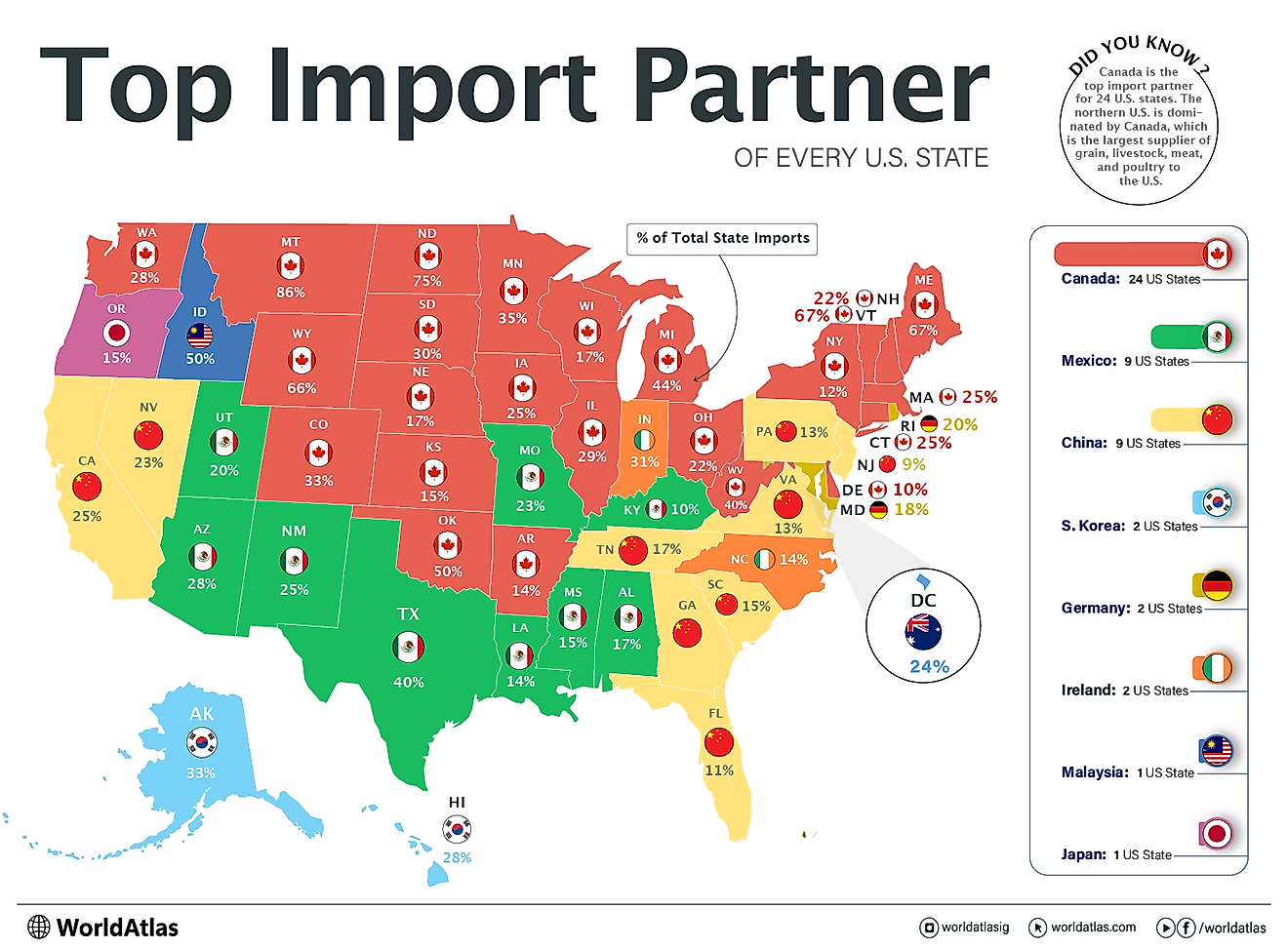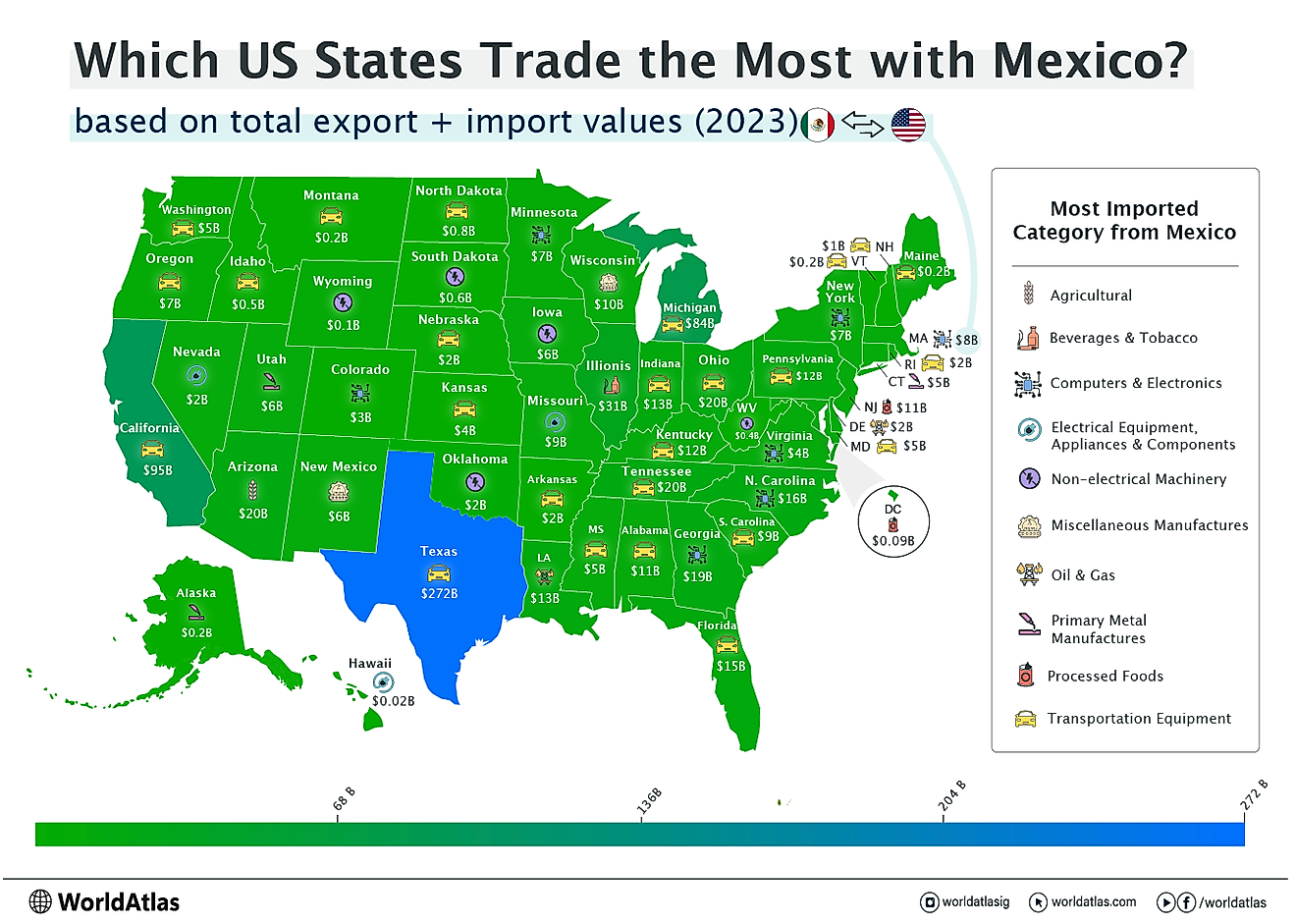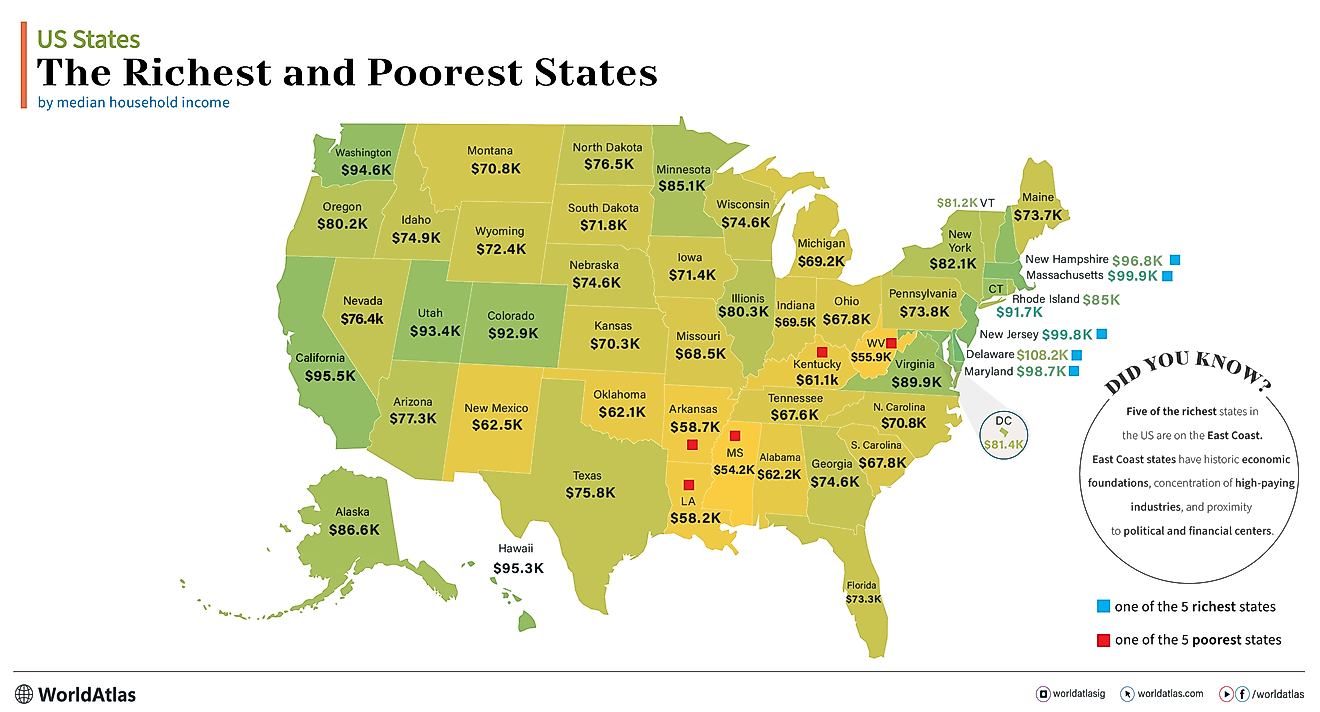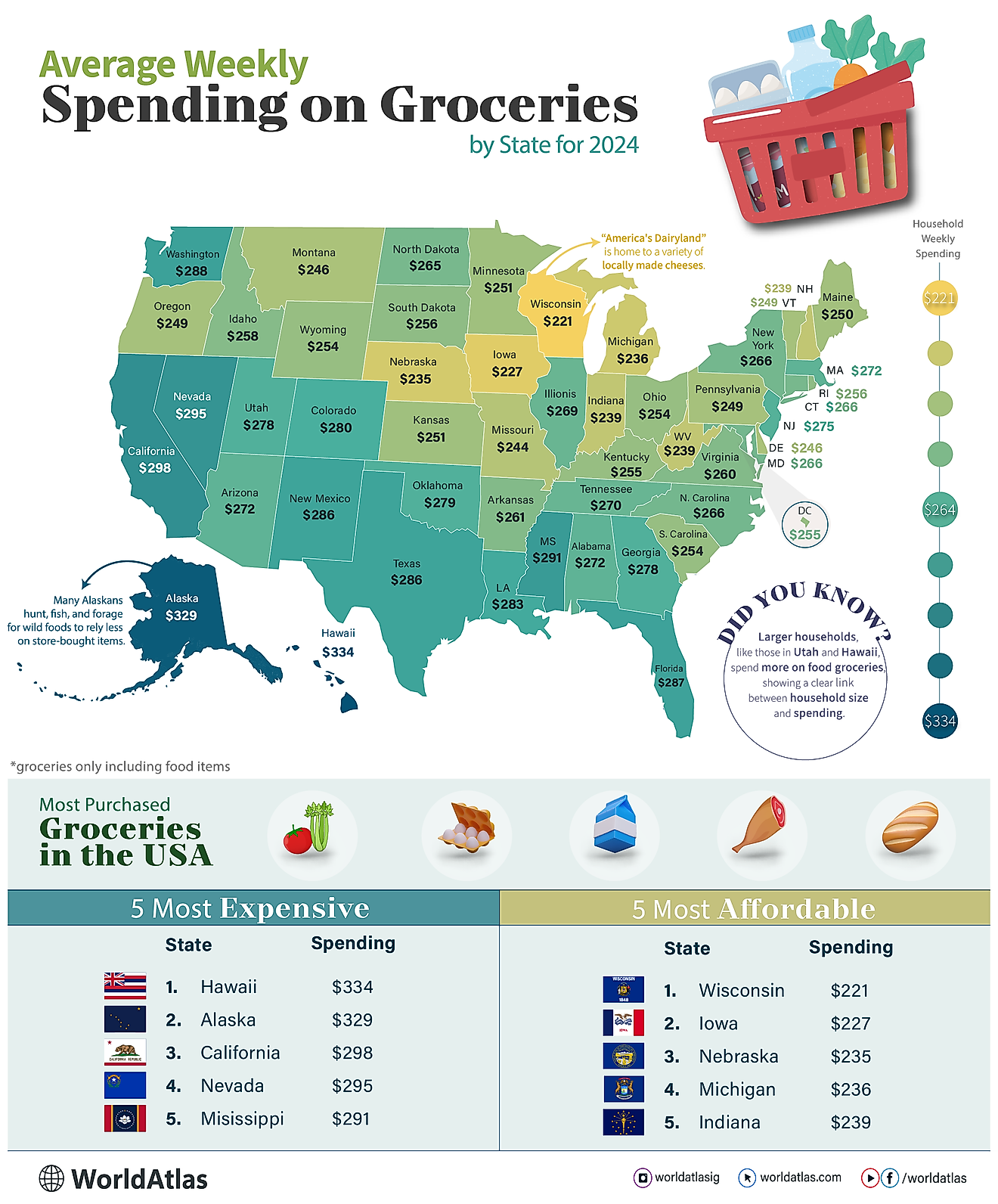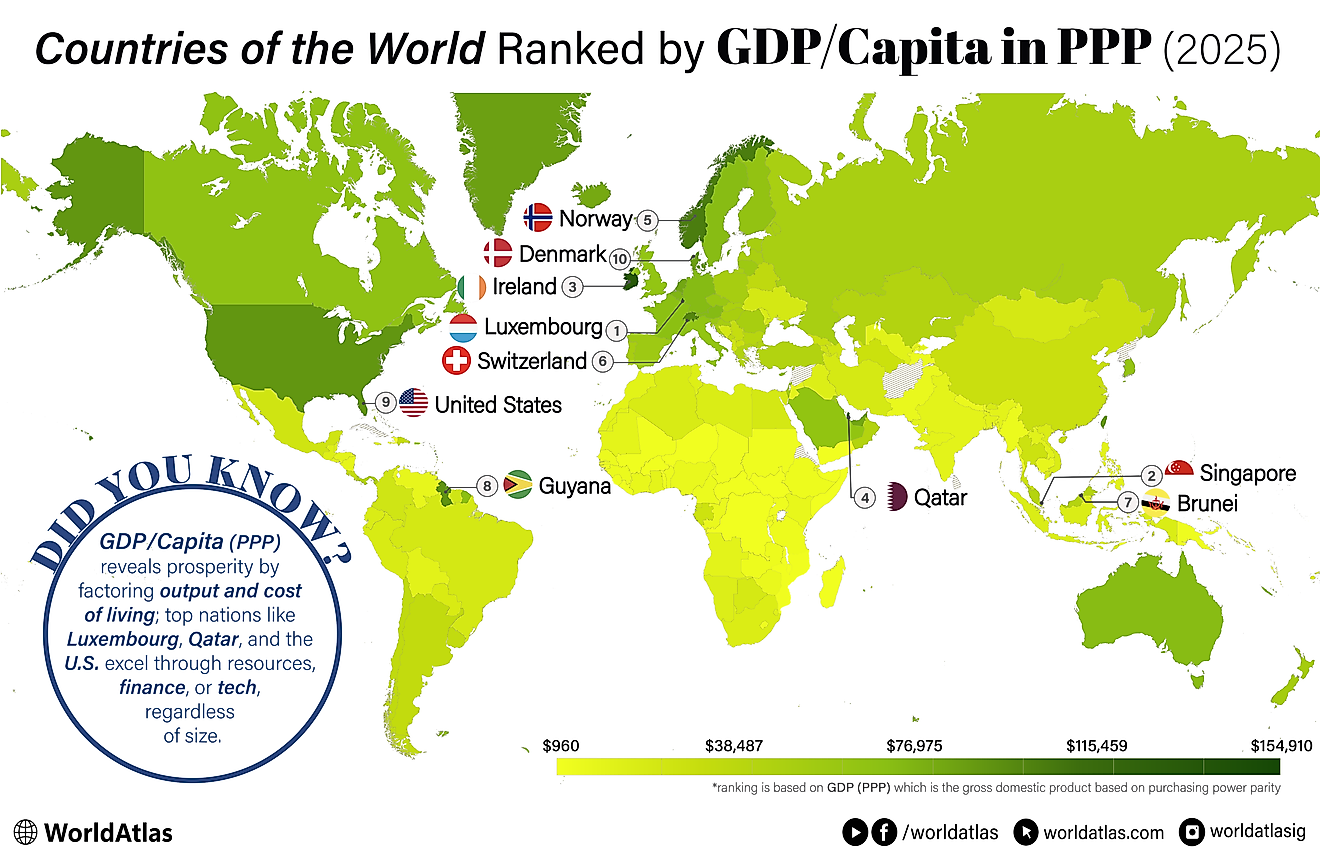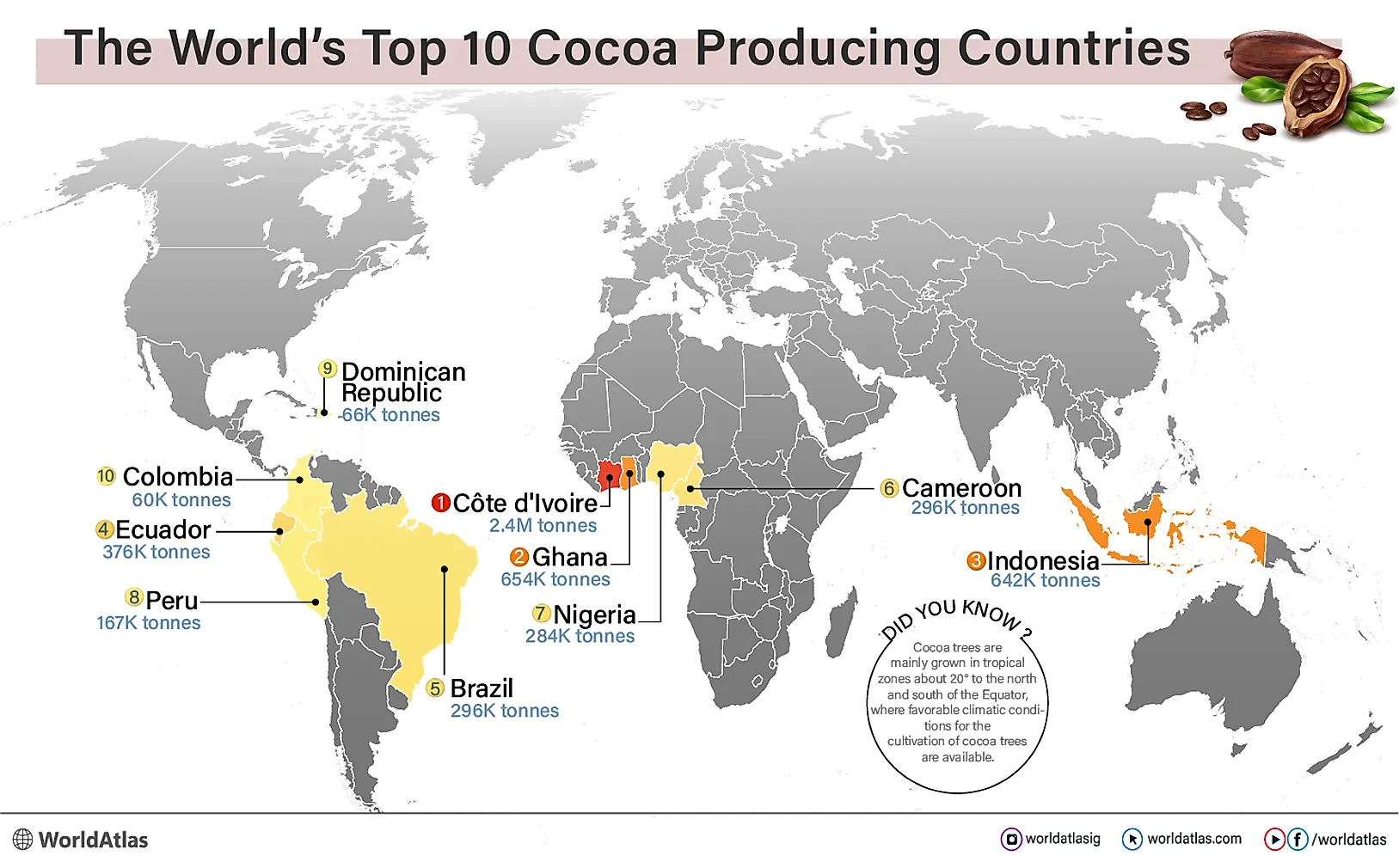
Top 10 Cocoa Producing Countries in the World
The sheer scale and volume of cocoa production is remarkable. As of 2023, the total cultivation of cocoa is over 5 million tonnes per year. To put that in perspective, that's equivalent to 11.023 billion pounds. In monetary terms, cocoa production reached an astounding $16 billion in 2023, with projections indicating a rise to $22 billion by 2028, reflecting a seven percent increase in value per year. Cocoa’s versatility is unmatched, serving as the foundation for beloved products like chocolate, cocoa powder, and cocoa butter, as well as cocoa-based beverages such as hot cocoa, smoothies, and even energy drinks. Beyond the culinary world, cocoa’s fatty acids and beneficial properties make it a sought-after ingredient in cosmetic products. Fascinatingly, nearly half of the world’s cocoa comes from just two countries, Côte d'Ivoire and Ghana. This article will delve into the top 10 cocoa-producing countries across the globe, highlighting their contributions to this thriving industry.
Côte d'Ivoire — 2,377,442 tons

Côte d'Ivoire, also known as Ivory Coast, stands in a league of its own as the world's biggest supplier of cocoa beans, with exports valued at $3.33 billion in 2023. Raw cocoa beans make up 70% of exports, while cocoa paste accounts for 12% and cocoa butter for 7%. The industry has a wide network of stakeholders, including 200,000 farmers in the Cocoa Life community, a network dedicated to building partnerships and new initiatives for the betterment of all stakeholders. In recent years, the West African nation has dealt with a wide array of geopolitical challenges and the effects of anthropogenic climate change. However, the overall situation remains stable and conducive to continued production growth. An October report from 2024 highlighted a bullish 10% increase in the harvest forecast for 2024-2025, following a new pod count, which involves assessing the number of cocoa pods on trees during a specific period.
Ghana — 653,700 tons

Second on the list is Ivory Coast's neighbor, Ghana. In 2023, the total export value of Ghana's cocoa production reached $1.17 billion, based on figures from the World Integrated Trade Solution. For Ghanaians, cocoa is an integral part of their economy and livelihoods. In fact, a famous aphorism in Ghana is: "Ghana is cocoa, cocoa is Ghana." With as many as 800,000 people directly or indirectly involved, the outlook for Ghana's cocoa industry is mostly positive. Like its previously mentioned neighbor, Ghana faces challenges such as climate change and volatility in prices. Given the recent warmer-than-usual weather and inadequate rainfall, industry experts lowered Ghana's production output by five percent in September.
Indonesia — 641,741 tons
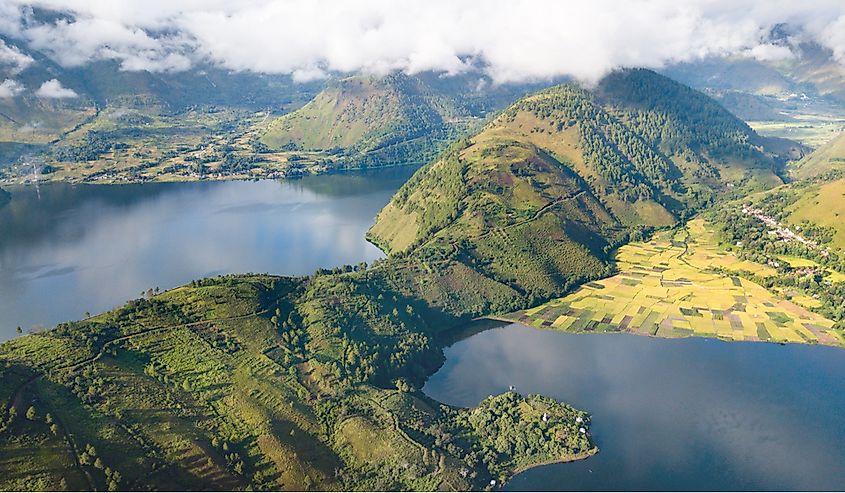
Thanks to increasing involvement from local farmers and other stakeholders, Indonesia has become a key player in the global cocoa market over the last few decades. In 2023 alone, the country produced 641,741 tons of cocoa, with exports reaching a value of $47 million. Currently, over 31,000 farmers engage in the cultivation of cocoa beans via the Cocoa Life program, which has been active in the country since 2013. The majority of production occurs in five primary regions: Sulawesi, North Sumatra, West Java, Papua, and East Kalimantan. Indonesia only began producing cocoa on an industrial level in the 1970s, so the lack of knowledge compared to other nations with more experience remains a challenge. Nonetheless, as the demand for cocoa grows, the industry looks ready to meet the challenge, and the future outlook for the Indonesian market is expected to steadily increase. For 2026, experts estimate that Indonesia may produce 836,000 metric tons of cocoa.
Ecuador — 375,719 tons

Ecuador may produce less cocoa than giants like Ghana and Indonesia, but its cocoa industry is a cornerstone of the national economy and holds a unique place in the global market. In 2023, Ecuador produced 375,719 tons of cocoa, with around 150,000 families involved in cultivating the prized red-brown beans. Many of these farmers live in rural areas across the Andes and Amazon regions, where the unique geography gives Ecuadorian cocoa its distinct floral flavor. This characteristic taste has earned the country 65% of the global market share of fine aromatic cocoa.
The renowned Nacional variety is especially sought after for its complex flavor and high quality. With rising global demand for premium cocoa, Ecuador is well-positioned for growth. Increased investments and growing domestic demand are set to boost production in the coming years, further cementing Ecuador’s reputation as a leader in fine cocoa exports.
Brazil — 296,145 tons

Brazil produces some of the finest, high-quality cocoa beans in the world, and its farmers' dedication and sustainable practices have earned global recognition. In 2023, Brazilian cocoa was honored at the Cocoa of Excellence Awards in Amsterdam, a prestigious accolade celebrating producers who prioritize sustainability, innovation, and ethical business practices. While Brazil's cocoa production has declined since its peak of 430,000 tons in the 1980s, the country remains a key player in the global market.
In 2023, Brazil produced nearly 300,000 tons of cocoa, exporting over $2 million worth of beans. However, challenges such as limited access to capital and the effects of climate change continue to impact growth. Despite these hurdles, Brazil’s resilient farmers remain optimistic. With continued investment and favorable conditions, experts believe the country can reach 400,000 tons of production by 2030 without any unforeseen problems.
Cameroon — 295,819 tons
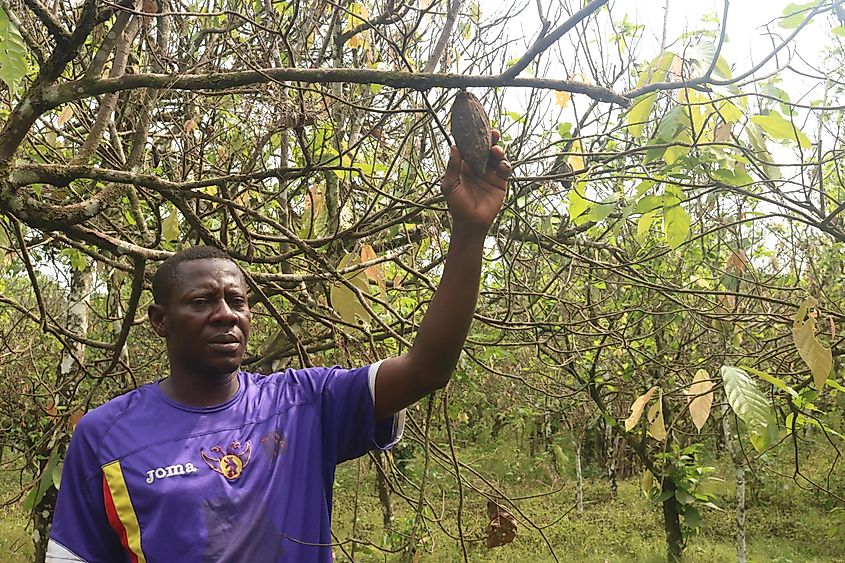
Cameroon has long benefited from an ideal climate for cocoa cultivation, producing 295,819 tons in 2023. However, unlike some of the larger producers on this list, Cameroon exports a smaller share of its total output, as much of its cocoa is processed domestically or sold within regional markets. The quality of Cameroon's cocoa has steadily improved over the years, with large portions classified as Grade I—a significant upgrade from previous concerns about bean quality.
Most of Cameroon's cocoa production is concentrated in the central and southwest regions, which account for over 40% of the country's total output. Since 2017, Cameroon has implemented a comprehensive roadmap focused on maximizing efficiency, improving sustainability, and engaging more collaboratively with stakeholders. While challenges like infrastructure and market access persist, Cameroon’s cocoa industry is showing steady progress, with producers aiming to boost exports and expand their global footprint in the years ahead.
Nigeria — 284,232 tons

Nigeria's cocoa producers are on a roll, reaching a production of 284,232 tons in 2023. Production also saw a boost of around 10% in 2024 as a result of conducive weather in the southwestern area. And investors are noticing the uptick, which may increase capital investment in the sector. The forecast for Nigeria's cocoa economy may rise to $25 billion, according to some estimates, if global demand continues to increase and farmers are able to produce. To this end, the country also has stable cocoa exports, reaching a value of nearly $700 million in 2023.
However, like other countries, challenges such as inequality, precarious labor, and climate change could jeopardize this goal if left unaddressed. Another issue gaining attraction is the presence of illegal trade networks, or illicit markets, where cocoa plantations are being established in protected areas. Undercover markets may ostensibly aid the supply side, but it could also erode trust in the industry and deter potential investors.
Peru — 166,708 tons
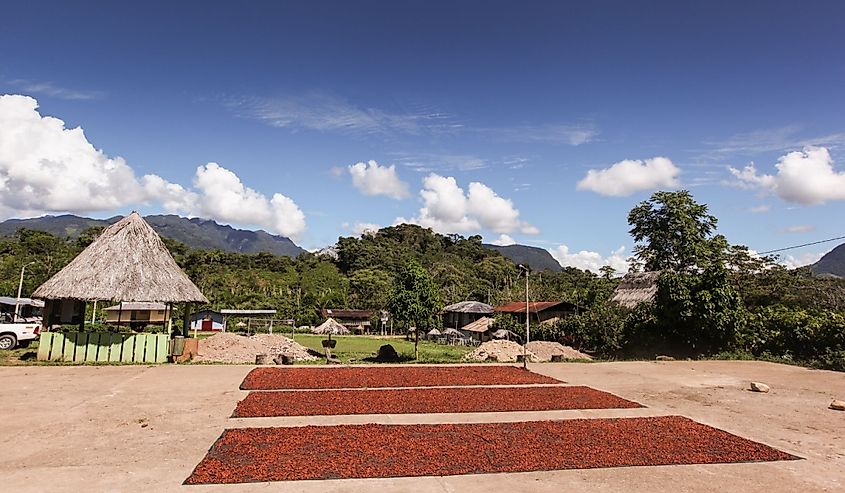
Peru exported approximately $225 million worth of cocoa beans in 2023 and produced 166,708 tons, making it the eighth-largest producer in the world. For Peruvians, cocoa is nothing new, as Indigenous communities here have been credited for crafting cocoa drinks as early as 1900 BC. Thanks to the long history of cultivation, the practice still exists today, employing around 50,000 proud Peruvians. Given the expansive size and unique characteristics of the Amazon, cocoa crops yield a wide variety of flavors, including fine varieties like Theobroma cocoa, which can be described as having an earthy and/or fruity flavor. Other variations of the bean offer aromatic flavors, adding to the rich diversity of Peru's cocoa industry. While a few challenges like pests, climate change, and soil degradation could hinder Peru's ability to produce cocoa on a greater scale, the Peruvian cocoa export is projected to increase by 2-5% from now until the end of the decade.
Dominican Republic — 65,930 tons
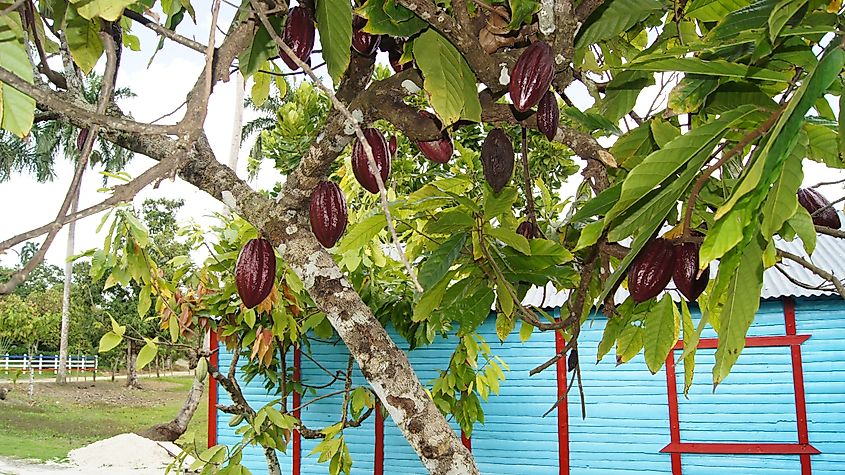
With a production of 65,930 tons in 2023 and exports valued at $192 million, the Dominican Republic’s cocoa industry remains a vital part of the country’s economy, providing livelihoods for over 35,000 families and 40,000 farms. Cocoa has a long history here; it was introduced in the 17th century and gradually gained momentum by the 19th century. While the Dominican Republic may not match the output of giants like Côte d'Ivoire and Ghana, it has carved out a niche as a leading supplier of premium, organic cocoa.
The island nation’s favorable climate, rich soil, and skilled farmers contribute to the high-quality beans sought after by chocolate connoisseurs worldwide. This focus on organic production has given the Dominican Republic a strong reputation in the global market, with steady growth expected to continue. To this end, production is projected to rise by 4.4% through 2029.
Colombia — 59,831 tons
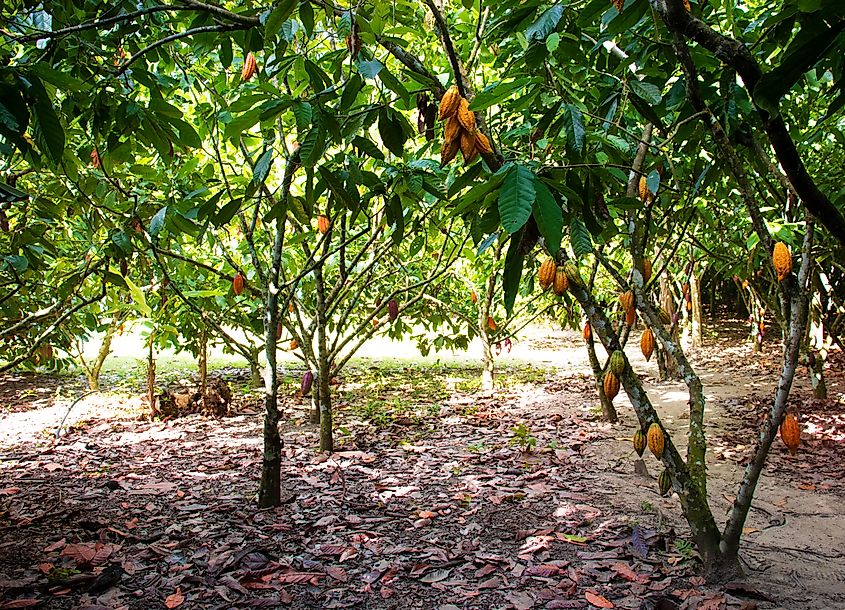
Colombia has been a quiet player in the cocoa world, but this may not be the case forever. In 2023, the country produced 59,831 tons of cocoa, with exports valued at $13.5 million. Between 2014 and 2021, Colombia's cocoa production increased by 36.5% thanks to a wide range of initiatives, such as data-driven analysis and stronger connections between producers. The United States, the world’s largest economy, remains the leading customer of Colombia's cocoa subproducts, boosting business and encouraging further growth in the sector. If the trend continues, Colombia could be well on its way to securing a larger share of the global cocoa trade.
Final Thoughts
In conclusion, the global cocoa industry plays a crucial role in the economies of producing countries, particularly Côte d'Ivoire and Ghana, which dominate the market. While consumers have enjoyed the benefits of cocoa beans and the many delicious products that come from them, challenges such as climate change and fluctuating prices continue to persist, making the outlook for cocoa production uncertain. On the bright side, with growth anticipated in many regions, such as Indonesia and Brazil, prices could stabilize in the long run, assuming sustainable practices and cooperation between various stakeholders are adopted.
Top 50 Cocoa Producing Countries
| Country | Production Quantity in Tonnes |
|---|---|
| Côte d'Ivoire | 2377442.05 |
| Ghana | 653700 |
| Indonesia | 641741.02 |
| Ecuador | 375719.14 |
| Brazil | 296145 |
| Cameroon | 295819.38 |
| Nigeria | 284232.16 |
| Peru | 166708.8 |
| Dominican Republic | 65930.13 |
| Colombia | 59831 |
| Papua New Guinea | 43200 |
| Democratic Republic of the Congo | 35000 |
| Uganda | 35000 |
| India | 30000 |
| Venezuela (Bolivarian Republic of) | 29358.83 |
| Mexico | 29047.4 |
| Guinea | 23164.05 |
| Liberia | 20000 |
| Madagascar | 20000 |
| Sierra Leone | 18000 |
| Togo | 15000 |
| United Republic of Tanzania | 12000 |
| Guatemala | 11652.4 |
| Philippines | 10759.12 |
| Congo | 10000 |
| Nicaragua | 9317.11 |
| Bolivia (Plurinational State of) | 5971.18 |
| Sao Tome and Principe | 4000 |
| Solomon Islands | 4000 |
| Haiti | 2500 |
| Honduras | 2000 |
| Vanuatu | 1500 |
| Cuba | 1387.54 |
| Sri Lanka | 1320.8 |
| Viet Nam | 1206.84 |
| Dominica | 1000 |
| Equatorial Guinea | 1000 |
| Costa Rica | 800 |
| Panama | 562 |
| Guyana | 484.1 |
| Samoa | 481.76 |
| Angola | 458.24 |
| Grenada | 364 |
| El Salvador | 362.8 |
| Trinidad and Tobago | 300 |
| Malaysia | 269 |
| Belize | 233 |
| Saint Vincent and the Grenadines | 229.13 |
| Timor-Leste | 175.1 |





